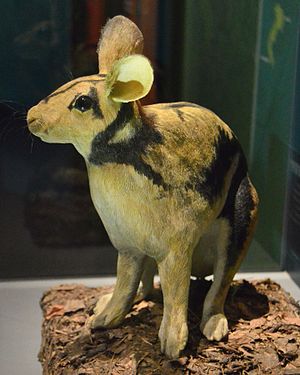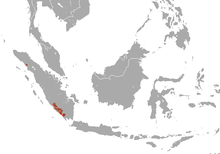Sumatran rabbit
| Sumatran rabbit | ||||||||||||
|---|---|---|---|---|---|---|---|---|---|---|---|---|

Preparation of a Sumatran rabbit |
||||||||||||
| Systematics | ||||||||||||
|
||||||||||||
| Scientific name | ||||||||||||
| Nesolagus netscheri | ||||||||||||
| ( Schlegel , 1880) |
The Sumatran rabbit ( Nesolagus netscheri ) is a species of mammal belonging to the genus of the striped rabbit within the hare-like species . It is endemic to the island of Sumatra and is considered one of the rarest species of hare-like in the world.
features
The size of the Sumatran rabbit roughly corresponds to the wild rabbit ( Oryctolagus cuniculus ) introduced to Sumatra , with which it is often confused by the locals. It has a head-torso length of 36.8 to 41.7 centimeters. The basic color of the body is yellowish-brown and the animal has broad dark brown to black stripes that extend lengthways across the body; however, these are individually different and can also be missing. The belly side, the chin and the inside of the legs are white. The fur is short and soft.
The ears are comparatively short with a length of 6.7 to 8.7 centimeters. They are black and, when folded out, reach no more than the eyes. Compared to the wild rabbit, the head is wider with a shorter snout and the legs are also significantly shorter. The tail measures 1.7 centimeters and is so short that it is normally not visible at all. It contains only 12 bones as opposed to the usual 19 to 24 other types.
distribution and habitat
The Sumatran rabbit is endemic to the Indonesian island of Sumatra . It is found at seven sites, which are mainly in the Barisan Mountains in the west-central and south-west part of the island. One sighting from 1972 comes from the Gunung Leuser National Park in the north-west of the island, another possible sighting from 1978 from the area around the Kerinchi .
The altitude distribution of the species is between 600 and 1600 meters. The preferred habitat of the species are remote mountain forests, the soil of which contains volcanic ash.
Way of life
The Sumatran rabbit is strictly nocturnal and during the day hides in holes in the ground or in residential structures that have usually been dug by other animals. Accordingly, most of the rare sightings come from forest construction measures, in which forest areas were converted into tea and coffee plantations. The food consists of plants from the undergrowth in the forest. No data are available on the reproduction of the animals.
Systematics
The Sumatran rabbit is assigned to the striped rabbit (genus Nesolagus ) as an independent species . It was first scientifically described by Hermann Schlegel in 1880 as Lepus netscheri . The classification in its own genus Nesolagus took place in 1899 by the Swiss Charles Immanuel Forsyth Major and it was considered the only species of the genus until the description of the Annamite striped rabbit in 2000.
Hazard and protection
The Sumatran rabbit has been classified as endangered (vulnerable) by the International Union for Conservation of Nature and Natural Resources (IUCN) since 2008. The species is classified as a naturally rare animal, as it is very little known among the population. Between 1996 and 2008, the species was critically endangered, as only about a dozen museum specimens from the period between 1880 and 1916 and only a few sightings are known. In 1998, 1999, 2007 and 2008 the species was captured once with a camera trap
The main threats to the Sumatran rabbit come from habitat changes by humans. The usable habitats on the island are estimated to be less than 20,000 km 2 in total.
supporting documents
- ↑ a b c d e f g h John EC Flux: The Sumatran Rabbit Nesolagus netscheri In: Joseph A. Chapman, John EC Flux (ed.): Rabbits, Hares and Pikas. Status Survey and Conservation Action Plan. (PDF; 11.3 MB) International Union for Conservation of Nature and Natural Resources (IUCN), Gland 1990; Pp. 137-142. ISBN 2-8317-0019-1 .
- ↑ a b c d e f g Nesolagus nets cheri in the endangered Red List species the IUCN 2011. Posted by: E. Meijaard, J. Sugardjito, 2008. Accessed June 11, 2012th
- ↑ a b Don E. Wilson & DeeAnn M. Reeder (eds.): Nesolagus netscheri in Mammal Species of the World. A Taxonomic and Geographic Reference (3rd ed).
- ↑ AO Averianov, AV Abramov, AN Tikhonov: A new species of Nesolagus (Lagomorpha, Leporidae) from Vietnam with osteological description. Contributions from the Zoological Institute 3, St. Petersburg 2000 3; Pp. 1-24.
- ↑ WWF Save Sumatra (2009) photo terbaru spesies Kelinci langka. Retrieved June 11, 2011.
literature
- John EC Flux: The Sumatran Rabbit Nesolagus netscheri In: Joseph A. Chapman, John EC Flux (Ed.): Rabbits, Hares and Pikas. Status Survey and Conservation Action Plan. (PDF; 11.3 MB) International Union for Conservation of Nature and Natural Resources (IUCN), Gland 1990; Pp. 137-142. ISBN 2-8317-0019-1 .
Web links
- Nesolagus nets cheri in the endangered Red List species the IUCN 2011. Posted by: E. Meijaard, J. Sugardjito, 2008. Accessed June 11, 2012th
